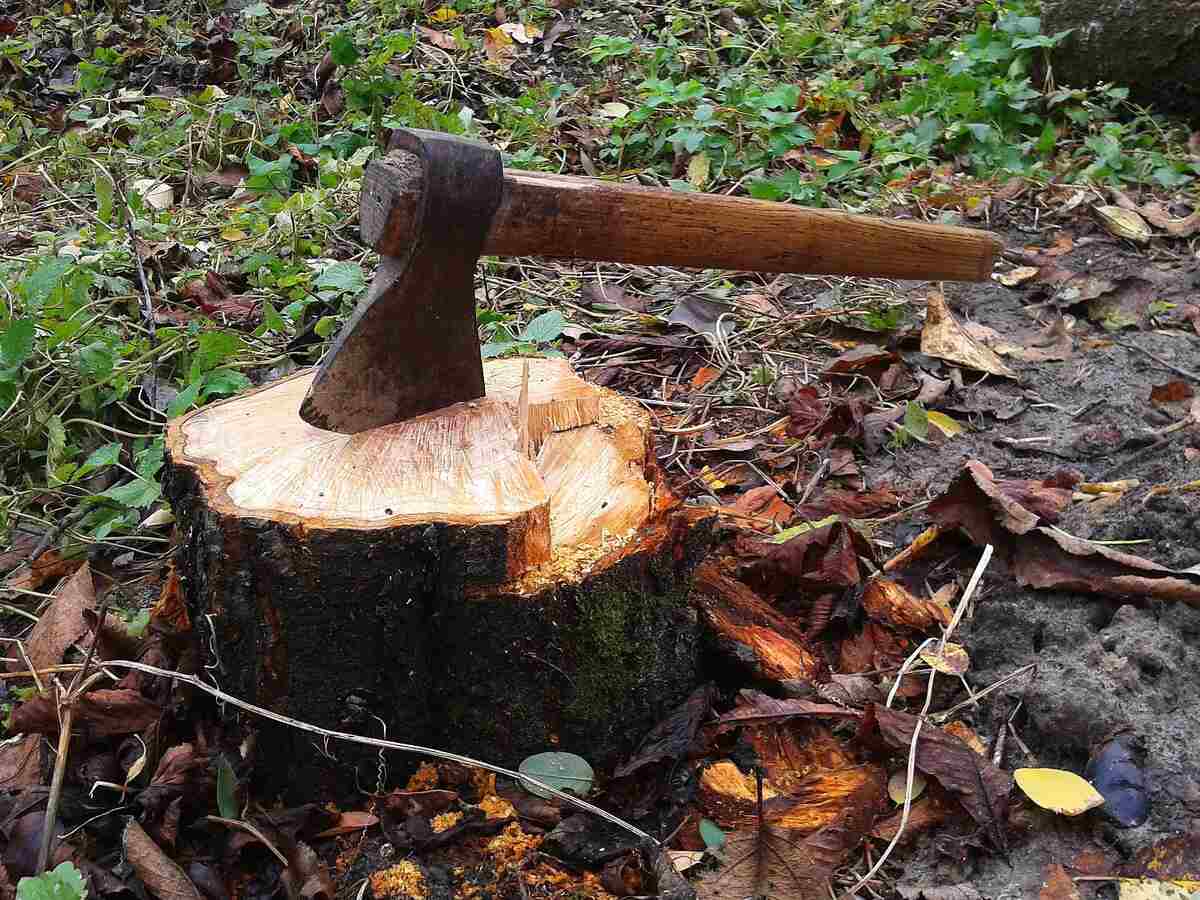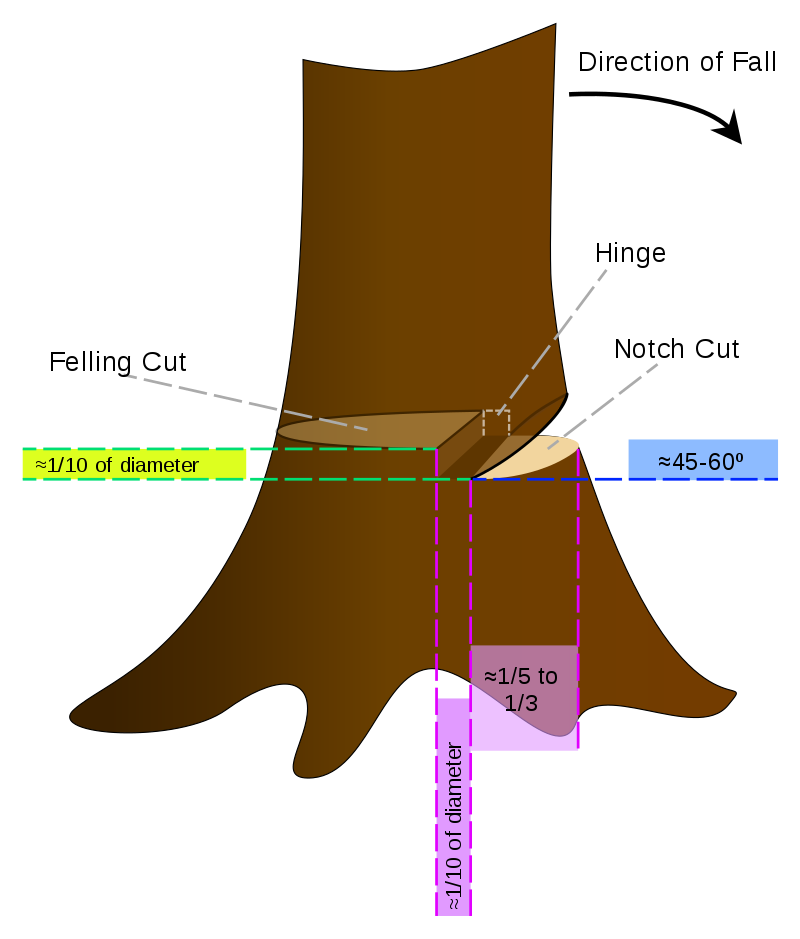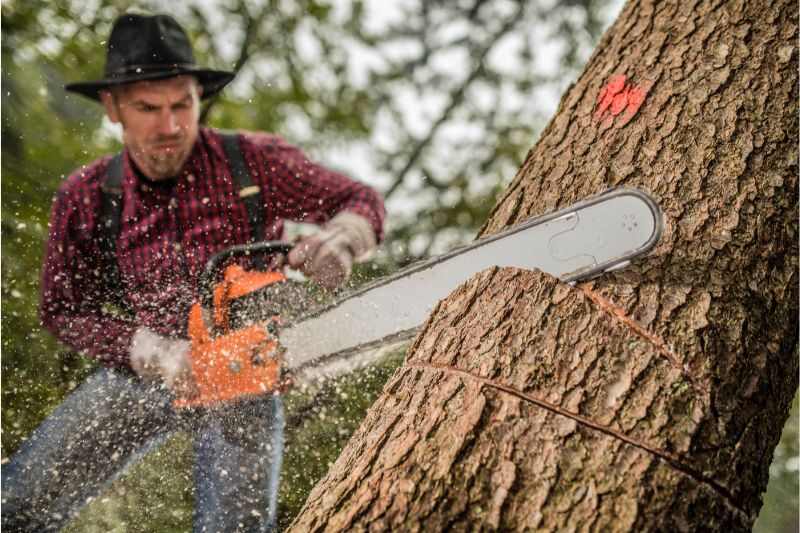
So, you want to cut down a tree and a lumberjack like Paul Bunyon isn’t available to help. If you’re comfortable with a chainsaw, some trees are easily taken down on your own. But others are best left to the experts. If you’re trying to decide whether to cut or not, here’s how to cut down a tree safely in 10 steps.
If it feels like tree cutting is too much for a weekend DIY project, or you’d rather a pro do the job, feel free to skip to Step 10.
1. Decide if it’s Safe
If you want to cut down your own tree, you’re probably looking to fell something a bit bigger than the struggling fruit tree you planted three years ago. This means you need to take safety precautions from the start.
Assess the tree’s condition. You’ve already given the tree a checkup to see if it needs to come down, but take another look. If it has a lot of broken, loose, or dead branches, or if your tree is diseased or dying, skip to the final step in this guide. A dead tree and its branches will come down on you and could cause serious injury.
Walk around the tree and your property and look for obstructions, including buildings, electrical boxes, and heavy growth.
Use caution if power lines are nearby. Don’t attempt to cut down a tree if there’s any chance it could fall on the lines, or your equipment could touch the lines. For dangerous or large trees, call your power company.
Estimate the fall area and determine where the tree will land. If any obstacle is in the way, skip to Step 10.
2. Gather Equipment

Next, assemble the proper safety gear. Here’s what you need:
- A hard hat
- Safety glasses
- Hearing protection
- Work gloves
- A chainsaw
- Felling wedges
Note: You may need a permit from your homeowners association or city, so check local regulations before cutting down a tree with a chainsaw. And for safety, enlist a trusted friend or family member. Two sets of eyes are always better than one. Plus, you need someone to yell, “TIMBER!”
3. Estimate the Fall
It can be difficult to measure the exact height of the tree and determine where it may fall. Assess the tree for uneven growth, whether due to disease, overcrowding, or any other factor. If the tree is heavier on one side than another, it will fall that way regardless of your attempts to redirect it.
- For a better estimate, hold an ax at arm’s length, and close one eye.
- Walk until the top and bottom of the tree are aligned with the top and bottom of your ax.
- Where you stand is roughly where the top of the tree will fall.
4. Clear Escape Routes
Make sure you have a safe escape path to retreat from the worksite. It’s best to have two routes away from the direction of the falling tree and ensure they’re clear from debris. If something goes wrong, you want a direct path to safety.
5. Plan the Notch
To ensure the tree falls in the desired direction, the notch cut should be made on the “fall side” of the tree, which is typically the heaviest side. This will enable the tree to fall in the intended direction rather than in the opposite direction.
Cut at a comfortable working height. If it feels like the stump will be too big, remember you can cut down the base of the tree later.

How to cut down a tree with a chainsaw
Photo Credit: Amada44 / Wikimedia Commons / CC BY-SA 3.0
6. Cut the Notch
- Start with the top cut, moving at about a 45-degree angle downward.
- Cut about one-third of the way into the trunk.
- Below that, make a second cut parallel to the ground. This horizontal cut should come pretty close to meeting the first cut.
7. Insert Wedges
Depending on the tree, wedges may be necessary. If the tree’s diameter is more than 18 inches, wedges will help prevent your saw from getting pinched. You can purchase these at any home supply store.
- Once a notch is cut, begin the felling cut (Step 8).
- As soon as you’ve cut enough to insert wedges, stop cutting and pound in the wedges; then complete the cut.
8. Make the Felling Cut

This is what will actually make the tree fall.
- Move to the opposite side of the tree, away from the notch.
- About an inch or more above the notch, begin an even back cut. You want to create a hinge, so you will not cut all the way through.
- As the tree starts to move, stop the cut and take one of the paths to safety.
9. Remove Branches and Cut into Firewood
Once the tree is down, it’s time for the cleanup job, which is a two-step process:
Limbing. Simply put, you remove the branches from the tree trunk. But take a few precautions:
- Evaluate the area. Make sure the tree isn’t hanging from another tree, wedged between trees, or has fallen on a tree that will spring up to hit you.
- Stand on the uphill side of the tree and be sure of your footing.
- Start at the bottom and work your way up, cutting branches on the opposite side of the tree.
Bucking. This is where you cut the tree into sections. A few tips:
- Measure the size of your fireplace, stove, or fire pit before you start.
- Start from the uphill side and be sure of your footing in case the log should roll.
- Cut about three-quarters of the way through to avoid touching the ground with your saw. Then roll the trunk, and complete the cut.
But don’t rush to bust out the marshmallows when you finish. Green wood doesn’t burn well; in a fireplace, it can cause creosote buildup that can lead to a fire. So give your wood six to 12 months to season properly.
And remember, there are specific rules about transporting firewood in order to prevent the spread of pests.
10. Get Expert Tree-Cutting Help

Cutting down a large tree is often reason enough to call in a professional. If you’re still on the fence about cutting down a tree, ask yourself some questions:
- Can I ensure my safety and the safety of others when I’m cutting a tree down?
- Can I ensure the safety of my property or my neighbors’ property?
- Do I have the proper equipment for effectively cutting trees?
- Do I feel confident in my skills?
If the answer is “no” to any of those questions, hire a licensed and insured arborist.
Another question to ask yourself is, “How much will this cost?” To get an idea of how much professional tree services cost, check out a few of our pricing guides:
Once you’ve made your decision, round up the kids to watch them work — just make sure they keep their distance.
FAQ
What Wood Produces the Best Heat Value When Burned?
Hickory, oak (red or white), black locust, and honeylocust are some of the trees that have denser wood and thus produce more heat when the wood is burned, according to the University of Arkansas.
Heat value is determined by the density and moisture content of the wood. The more dense the wood, the more heat it releases.
What Safety Precautions Should I Follow When Using a Chainsaw?
Chainsaws are great tools, but operating them can be hazardous. A few chainsaw safety tips from OSHA:
1. Check controls, chain tension, and all bolts and handles to make sure everything is functioning properly.
2. Never try to fuel a running or hot saw.
3. Wear proper personal protective equipment, including closed-toed shoes and hearing and eye protection.
4. Check the area for dirt, rocks, and debris before cutting. Look for nails, spikes, or other metal objects embedded in a tree before cutting.
How Do I Store the Firewood From My Tree?
A few tips from Cornell University:
● Stack the wood off the ground so it doesn’t pick up moisture. You can build your own rack to hold it or buy one.
● Store it away from the house. Firewood is a good hiding place for rodents, bugs, and other critters, so keep the pile several feet away to discourage visitors.
● Cover the wood. The idea of stacking is to let the wood dry. If you live in a climate that gets snow or a lot of rain, use a plastic tarp or metal sheeting to protect it. Just cover the top; leave the ends open so air can get in.
Call In The Pros
If, after reading this guide, you’ve decided that felling a tree is not a DIY project, then do your research and hire a professional tree removal company. A local pro will have the knowledge and experience to take down that tree cleanly and safely. Then you can plan what to do with that space in your yard.
Main Image Credit: Pixnio